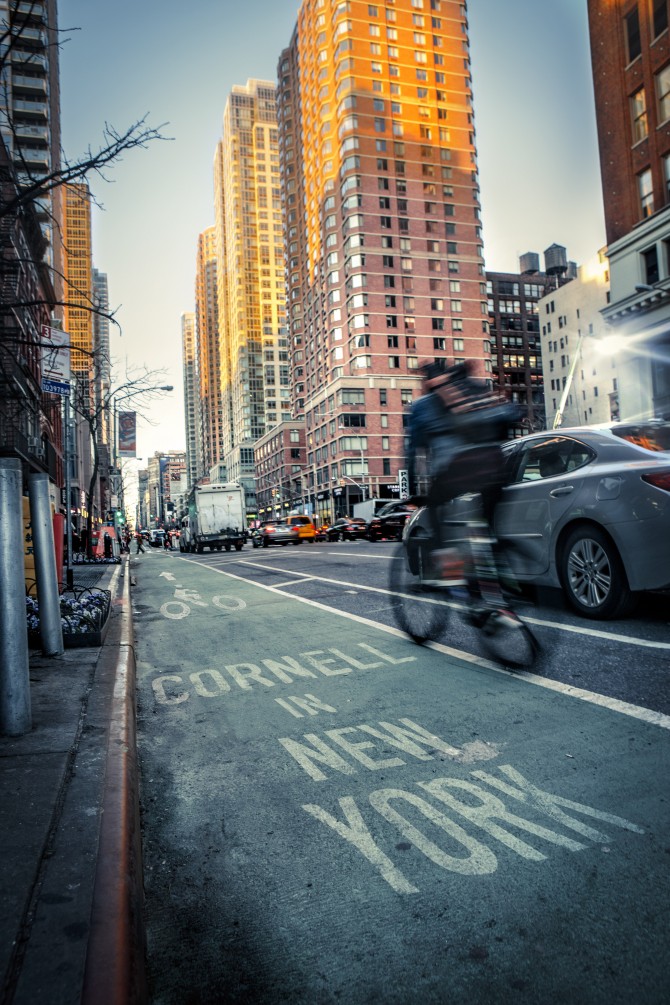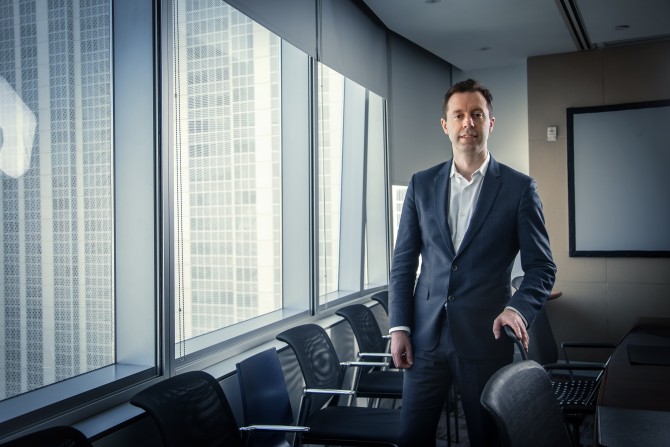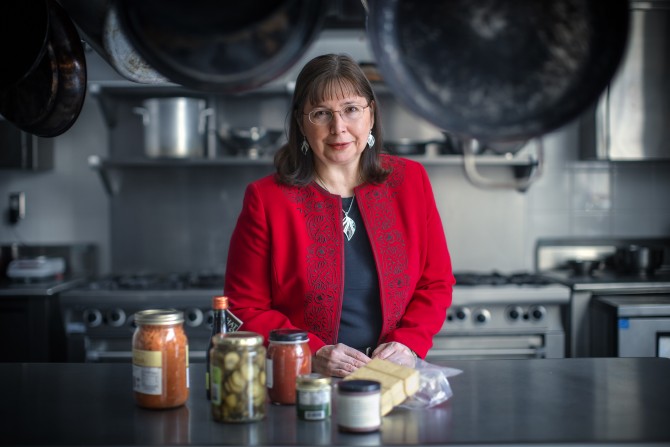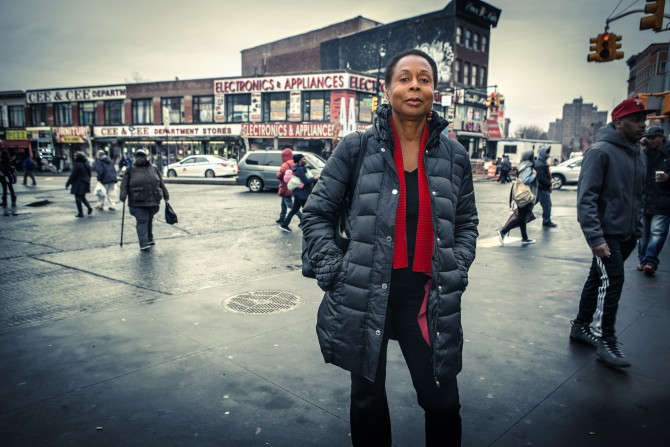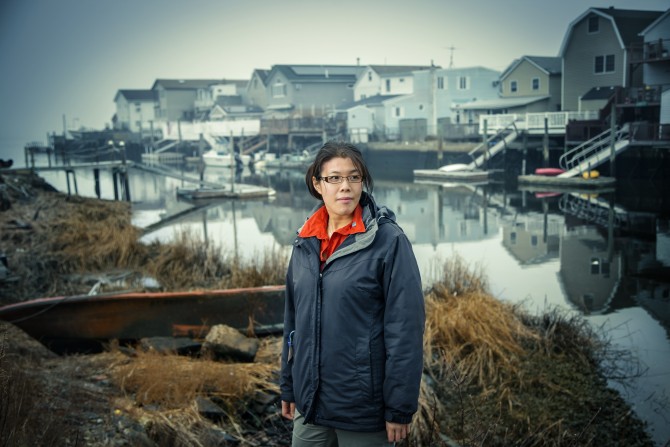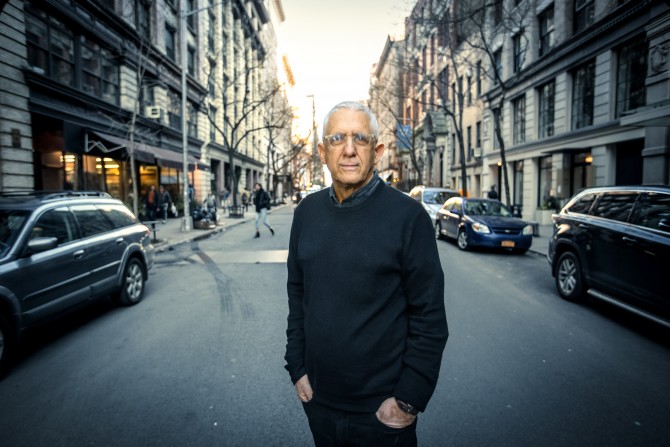
Nathan Kallus, assistant professor of operation research and information engineering at Cornell Tech.
A 'stronger, more holistic' impact
Through research, outreach and imagination, Cornell is an integral, growing part of New York City's future
By Olivia M. Hall
Cornell's Ithaca campus and its iconic upstate setting may be what many envision when they think of the university, but Cornell has long had a presence on the cosmopolitan stages of New York City.
The physical Cornell presence best known to those in NYC may be Weill Cornell Medicine (the institution first opened in 1898), but the Big Red footprint is much larger than that, and growing. For decades, Cornell University Cooperative Extension-NYC (CUCE-NYC) programs have improved the lives of city residents in all five boroughs – where just under 20,000 Cornell alumni make their homes.
College of Architecture, Art and Planning students have been studying at AAP NYC since 2006, and the ILR School, with NYC connections dating back to 1948, offers a Master of Professional Studies degree based in Manhattan. The new Cornell SC Johnson College of Business is growing its operations in NYC, including a dual-degree MBA/M.S. program with Weill Cornell Medicine and increasing partnerships with Cornell Tech. Steps away from Wall Street, Cornell Engineering's financial engineering satellite campus allows researchers and students to work on the technology that underpins global markets.
In short, nearly every facet of the university has at least one strong link – a program, an institute, a faculty research project – to the Big Apple.
The lead-up to the historic opening of the Cornell Tech campus this fall on Roosevelt Island has infused a new energy into this diverse array of programs, according to Jackie Davis Manigaulte '72, senior extension associate and director of community relations with CUCE-NYC and a longtime New Yorker.
"I think we're on the verge of a stronger, more holistic Cornell presence," she says. "There seems to be more synergy, interaction and coordination between the different efforts that are taking place."
Take, for example, last year's Big Red STEM day, an event hosted by Cornell Tech, Cooperative Extension, Weill Cornell Medicine and the city's Department of Education. The event aimed to introduce high school students to aspects of STEM (science, technology, engineering and mathematics) fields, and was staffed by Ithaca faculty and students.
"It was bigger and richer than anything one of our organizations could have done on our own," says Manigaulte. "Efforts like this make Cornell seem real and more accessible to people in the city."
Students pursuing the master's degree in health tech at Cornell Tech's Jacobs Technion-Cornell Institute and enrolled at Weill Cornell Medicine similarly take advantage of the potential of partnerships and collaborations. Students are not only able to take classes at each other's campuses but to share resources, data and space.
"Weill Cornell Medicine faculty have welcomed our students into their excellent courses," says Deborah Estrin, associate dean and professor of computer science, who also directs the health tech program at Cornell Tech; she also is professor of healthcare policy and research at Weill Cornell Medicine. "This cross-campus collaboration is slated to increase as we become geographic neighbors."
Cornell is deeply woven into the fabric of New York City in ways that have changed over time as research, knowledge and societal needs have evolved. Cornell has an impact on the lives of New Yorkers today (as well as people throughout the state, the nation and the world), and shares the entrepreneurial spirit that is driving the city's future.
Much of this research and work has organized itself, formally and informally, around interdisciplinary hubs that draw on the best of Cornell to tackle real-world challenges. Current work includes cutting-edge medical research and outreach; the food system, from farm to fork; and helping to bring citizens into dialogue with their representatives in the city and other levels of government.
"Campus is a state of mind, and New York is very much the Cornell campus," says Sam Bacharach, the McKelvey-Grant Professor of Labor Management who founded the ILR School's Institute for Workplace Studies in the city in 1999. "There's an energy to this place. … You supplement the intensity we bring to our work in Ithaca with the dynamics of New York, and you've got an unbelievable combination."
Here is a look at three areas where Cornell's research and outreach in New York City address the larger systems involved, broadening an approach that thrives on multidisciplinary strategies to improve lives.
HEALTH
Personalized diabetes care
Nearly one in 11 Americans suffers from diabetes, the seventh leading cause of death in the country. About 40 percent of the population will develop the disease in their lifetime, most frequently (90 to 95 percent) type 2 diabetes.
Despite evidence that different populations may respond differently to treatment options, current clinical guidelines are still somewhat of a blunt instrument and do not distinguish between patients based on their demographics, medical history or previous treatments.
"The standards of care are basically 'one size fits all,'" says Nathan Kallus, assistant professor of operations research and information engineering at Cornell Tech, whose research interests include data-driven optimization, decision-making, causal inference and machine learning.
With colleagues at MIT, he analyzed data from more than 10,000 type 2 diabetes patients at Boston Medical Center and modeled outcomes under 13 pharmacological therapies. Using this information, the team developed a prescriptive method for personalized type 2 diabetes care based on characteristics such as age, sex, race, BMI, treatment history and disease progression.
In 32 percent of the cases, "the algorithm recommended an alternative treatment from the standard of care," Kallus reports, noting that the subsequent results of that treatment showed a significant reduction in average blood sugar levels.
Because the study offers methodological suggestions, the researchers chose to publish their results in Diabetes Care, the leading medical journal on diabetes, hoping to attract the attention of medical practitioners who will run real-world trials.
This desire to make concrete changes similarly attracted Kallus to Cornell Tech: "First and foremost, I was drawn to the amazing people and research at Cornell University. And in New York, specifically, you can connect with the tech and medical fields to learn from them and teach them about your cutting-edge research in the hope to have a direct impact."
Computational biomedicine
Every patient's cancer is different. Olivier Elemento, associate director of the HRH Prince Alwaleed Bin Talal Bin Abdulaziz Al-Saud Institute for Computational Biomedicine at Weill Cornell Medicine, hopes to help provide them with highly individualized and precisely targeted treatment.
"We're taking a precision medicine approach," he says of the research that involves a large team across several institutions, including clinicians at Weill Cornell Medicine's Caryl and Israel Englander Institute for Precision Medicine, biomedical engineers at Cornell Ithaca, metabolomics experts at Weill Cornell Medicine-Qatar in Doha, and scientists at the Cornell Tech campus. "It's an attempt to improve how we deliver health care by trying hard to understand the molecular roots of each patient's disease and making a multitude of measurements that predict and help identify the best treatment options for each patient."
Elemento works closely with the affiliated hospital, NewYork-Presbyterian/Weill Cornell Medical Center, which provides patient data and samples. Sometimes his team can return treatment recommendations in as little as a week, but building the model on which they are based takes years – and massive amounts of data.
Much of this information stems from high-throughput sequencing, which delivers the makeup of an entire genome in just a couple of days.
"That's a really critical technology that allows us to peer down to the cells and understand what's driving them," says Elemento, who also is the Walter B. Wriston Research Scholar.
Sequencing can help to match mutations in the DNA of cancerous cells to specific treatments and analyze cell RNA to see what genes are expressed in a tumor. It is also being used to monitor patient immune systems in an effort to predict and increase the currently small number of patients who respond to immunotherapy, a new form of cancer treatment that activates the immune system itself to find and kill tumor cells.
Elemento's approach to precision medicine relies heavily on high-performance supercomputing to process these large amounts of data. "But it's only one component," he explains, "because then you have to build predictive models. That's where artificial intelligence (AI) becomes critical."
In this case, AI consists of computer programs sifting through the data to forecast which treatments will be effective in a given patient, based on his or her individual combination of measurements of genetic, physiological and environmental factors. AI also can be used to predict whether or not a patient requires urgent treatment – for example, based on the expression of certain genes, whether a thyroid nodule is likely to be cancerous or benign.
While Elemento estimates the number of patients who have been treated by these methods number fewer than 100, that total is growing quickly, he says: "But even if we help prolong the life of only one patient, it's amazing."
Bedbugs
New York City is on the front lines of a war against a horde of tiny but powerful enemies. For nearly two decades, bedbugs have been crawling and biting their way through all five boroughs. While these flightless parasites are not known to spread disease when they feed on human blood, they can afflict their victims with itchy welts, anxiety and sleepless nights.
In this battle, you want Jody Gangloff-Kaufmann on your side. In her capacity as a senior extension associate with New York State Integrated Pest Management (IPM), which reports to Cornell Cooperative Extension, the specialist in community nonagricultural IPM has been advising city officials on strategies to combat the infestation.
"We were definitely the canary in the coal mine," says Gangloff-Kaufmann of the bedbug resurgence that hit the city after decades of only occasional reports (and well before reports rose throughout the rest of the country). She attributes the insects' quick spread to a general lack of awareness in the population and among pest control professionals and, possibly, to the elimination by the EPA of several toxic household pesticides. By its peak in 2010, the city saw a spike in housing violation complaints, well-known stores and buildings were making undesirable headlines as hosts to the bugs, and numerous hotels faced lawsuits from bite-riddled guests.
In 2009, Gangloff-Kaufmann joined New York City's 10-member Bed Bug Advisory Board, convened by then-Mayor Michael Bloomberg, to issue a comprehensive report on what it called "a pest like no other." Although the city has not implemented all the board's recommendations, such as forming a permanent task force, it has intensified training for agency staff and put up a detailed bedbug information website.
As awareness of the pest has increased – particularly among landlords, who are legally required to treat bedbugs immediately – and more effective pesticides have become available, the number of housing complaints has dropped consecutively for several years (by nearly 50 percent between 2012 and 2016). Periodic spikes in calls to pest control companies, however, show that the battle is far from over. "This will be ongoing for the foreseeable future," Gangloff-Kaufmann confirms. She, for one, continues her outreach by training city social workers, who help protect some of the most vulnerable citizens from the bugs.
FOOD SYSTEMS
The Brooklyn Grange
Among its many assets, New York City boasts the world's largest rooftop soil-based farms. Two and a half cultivated acres – 12 stories above the Brooklyn Navy Yard and at the flagship farm atop the six-story Standard Motor Products building in Queens – form the Brooklyn Grange, which sells more than 50,000 pounds of vegetables per year to community-supported agriculture, local restaurants and the public.
They also serve as a living lab to plant ecologist Tom Whitlow, associate professor of horticulture, and his doctoral student Yoshi Harada.
"Rooftop farming can be the ideal sandbox for precision agriculture," says Harada. Compared with complex in-ground agriculture, the discrete system allows for relatively easy collection of samples, monitoring and experimental manipulations.
As the Brooklyn Grange founders were eager to anticipate and avoid problems before they arose, the researchers launched a series of studies in 2011. Using an "adaptive management" approach, they give ongoing feedback from data collection that allows real-time changes to be made.
To the farmers' relief, Whitlow and Harada have not found any unusual contamination from urban pollution sources – such as vehicle emissions or particulate matter from brake linings – in the soil or vegetables.
They also have been working to optimize the farm's special soil mix to improve sustainable management of water and nutrients. Ideally, it should be lightweight to avoid an extra burden on the rooftop; able to hold enough water for such crops as salad greens and to aid the city in managing runoff during heavy rainfalls; and prevent excessive nitrogen runoff, which can contaminate surrounding bodies of water. One innovation implemented by Whitlow's team has been to substitute coir – a fibrous material from coconut husks with high moisture-holding capacity – for expanded shale in the engineered soil mix.
"We have not solved all problems yet because the system is so novel and still in its infancy," Harada says.
And while funding from such sources as the USDA Hatch program and Cornell's Atkinson Center for a Sustainable Future came to an end last year, Whitlow is pleased with what the project has accomplished: "It really hits all three of our missions – teaching, research and extension – dead center. There is still lots to learn, but we've made a giant step toward improving the sustainability of rooftop agriculture."
Geneva's Food Venture Center
The Food Venture Center (FVC) in Geneva, New York, has helped many a mom-and-pop enterprise launch its pickles, jams and BBQ sauces from the home kitchen into the commercial market. Take Rick Field, founder of Rick's Picks, who calls the center a "crucial bridge" on his pickle company's pathway from a humble stand at New York's Union Square greenmarket to becoming a national business with major supermarket clients.
An extension program of the Department of Food Science, the FVC currently fields some 1,200 requests per year for its services, which began in 1988. Most of these originate within the state, though clients call in from across the Northeast and beyond.
"We provide assistance to make sure that people entering the marketplace understand the regulations and are able to offer a product that is safe and stable under the conditions that they want to sell it," says Olga Padilla-Zakour, FVC director, professor and chair of the Department of Food Science.
For a fee, the team of five specialists evaluates each client's production process and samples to issue a "scheduled process." This legal document lists all formulations, critical control points, and steps that must be followed and documented. It not only ensures regulatory compliance and safe food for customers but also gives producers confidence in their work: "As a small, one-person operation, I found great solace, support and thorough instruction with the very professional and patient staff of the FVC," says Kerry Cheeseboro, who cooks up "Pop Sauce" in New York City.
The condiment is one of nearly 2,300 products in the New York City area on which the FVC has worked since a client database was established in 2000. Of these, Brooklyn alone accounts for almost half, with more than 1,000 products manufactured by 600 food producers.
"The Brooklyn area has become a very important source of new foods, incubators and commercial kitchens," says Padilla-Zakour, who is excited to be opening an FVC satellite office in the borough with funding support from the College of Agriculture and Life Sciences this May. "We strive to have a much better impact and meet the city's specific needs with more specialized services and training."
Nutrition education
Zoila D'Pinzón used to indulge in large amounts of bread and rice despite her diabetes – until she took classes through the Expanded Food and Nutrition Education Program (EFNEP) in her Queens neighborhood. "I learned that I could make little dietary changes," she says. "Now I feel great." Five years ago, D'Pinzón came full circle to begin teaching nutrition education classes herself, making her a prime example of the USDA-funded program's success.
For nearly 50 years, EFNEP has targeted low-income families across the nation. In New York City, the College of Human Ecology and Cornell Cooperative Extension bring the eight-week workshop series to 5,000 adults and 3,000 youth every year. It visits such impoverished neighborhoods as the South Bronx and Central and East Harlem, where residents frequently suffer from poor nutrition, chronic disease and obesity.
Working primarily in school settings, 35 educators use hands-on lessons, shared meals and a positive learning environment to convey evidence-based nutrition curricula. Analyses of pre- and post-surveys show that most participants significantly improve their diet (90 percent statewide), frequency of physical exercise (47 percent), food resource management (82 percent) and food safety practices (66 percent).
"What makes our program unique is that we hire what we call 'indigenous educators' or 'paraprofessionals' – people who come from similar backgrounds as our participants," says Carol Parker, CUCE-NYC program leader for the nutrition and health program area. "When we deliver classes, we look for 'spark plugs,' or individuals who demonstrate leadership skills and an interest in serving others."
Among them was D'Pinzón, who – like 90 percent of the program's educators – immigrated to the United States (she arrived from Mexico in 1987). Only a high school diploma is required to receive the comprehensive training that prepares them for working in their communities.
"They really transform as educators, because they become so confident, competent and capable," says Parker, pointing out that several have moved on to other careers in teaching or nursing. Course participants, in turn, are inspired by seeing one of their own succeed and return to help the community. And perhaps they will become the next educators themselves.
URBAN DESIGN AND PUBLIC ENGAGEMENT
New York Sea Grant
Jamaica Bay is an urban estuary at the southern end of the New York metropolitan area. Covering some 10,000 acres, it is home to a rich diversity of wildlife – as well as JFK International Airport.
"It's one of the most unique estuaries I've heard of in the nation, but many New Yorkers really don't know what Jamaica Bay is," says Helen Cheng, coastal resilience specialist with New York Sea Grant (NYSG) in partnership with the Science and Resilience Institute at Jamaica Bay (SRIJB).
The Brooklyn native hopes to change this through her work with those two institutions that focus on science-based outreach to coastal communities. NYSG, a cooperative program of Cornell and the State University of New York, is part of the National Sea Grant College Program run by the National Oceanic and Atmospheric Administration, and SRIJB, a partnership among academic institutions, government agencies, nongovernmental organizations and community groups.
Cheng engages communities through programs on topics that impact them in the dynamic environment of the coast. These include how to live alongside wildlife in the bay and how nature provides resources for hazard mitigation. Oysters, for example, can protect shorelines from erosion. A layperson-friendly podcast series about research around the bay is in the works.
Importantly, communication goes both ways: A series of climate forums is bringing together residents, scientists and decision-makers to discuss climate and weather preparedness for such potentially catastrophic events as the flooding and storm surges brought on by 2012's Superstorm Sandy.
"Getting these groups talking to each other in the same room and working harmoniously for a cause they all share is important," says Cheng, who is taking special care to reach out to communities who may feel disconnected from the rest of the city.
With these efforts, Cheng hopes to have an impact beyond the bay: "People don't realize that New York City is a series of islands," she says. "So how can we use Jamaica Bay as a model of resilience across the entire city?"
Amplifying public participation
Joshua Brooks, J.D. '15, an eGovernment Fellow at the Cornell Law School, wants to give voters a voice beyond the ballot box. So he has brought the work of the Cornell eRulemaking Initiative (CeRI) – a cross-disciplinary research group among the Law School, the Faculty of Computing and Information Science, and the Scheinman Institute of Conflict Resolution at the ILR School – to New York City.
CeRI has been educating the public and soliciting input on the work of federal agencies via the online participation platform Regulation Room for nearly a decade. Now the initiative has introduced an open-source version, SmartParticipation, at the local level to provide feedback to elected officials.
"It helps to equalize underrepresented stakeholders with stakeholders that are arguably overrepresented, such as lobbyists, in a very public and transparent way," he explains.
By making himself "a nuisance in the city for a year," he says, Brooks convinced the New York State Legislature to adopt SmartParticipation as its official comment site on the complex Move NY bill. Proposed by the eponymous nonprofit environmental lobby group, the legislation would introduce uniform bridge tolling into and out of Manhattan and thereby fund an agency responsible for broad aspects of city transportation.
In the meantime, Brooks expects the bill to die in committee for political reasons, but the public has participated via the platform to an unprecedented degree. While the highest number of comments the city had previously received on its old site was 95 (concerning a proposal to lift the ban on ferret ownership in the city), the Move NY bill garnered 145 comments.
"That's really good," says Brooks, who with the CeRI team will synthesize the feedback and present a report on what New Yorkers think about traffic in the city to lawmakers and the public.
His long-term goal is to have SmartParticipation supplement the city's existing rulemaking platform. The signs are hopeful, and interest in using the platform has been pouring in from such institutions as the World Bank and governments as far away as the United Arab Emirates, as well.
"Our technological product is outstanding," says Brooks. "Everywhere we take it, people are floored by it. I really want to have any kind of decision-making body that makes rules or laws to adopt [it]."
Olivia M. Hall, Ph.D. '12, is a freelance writer based in Ithaca.
Media Contact
Get Cornell news delivered right to your inbox.
Subscribe
